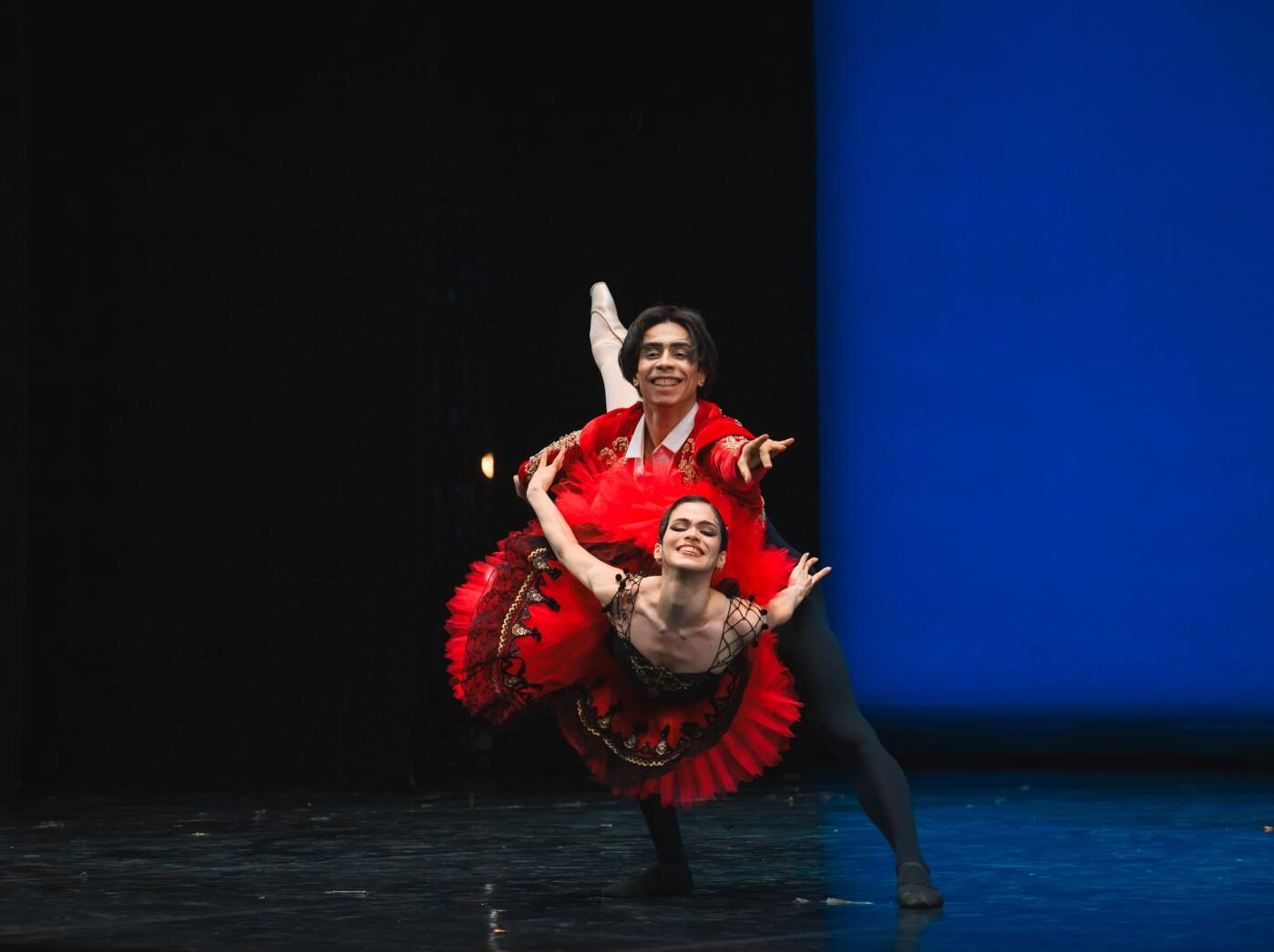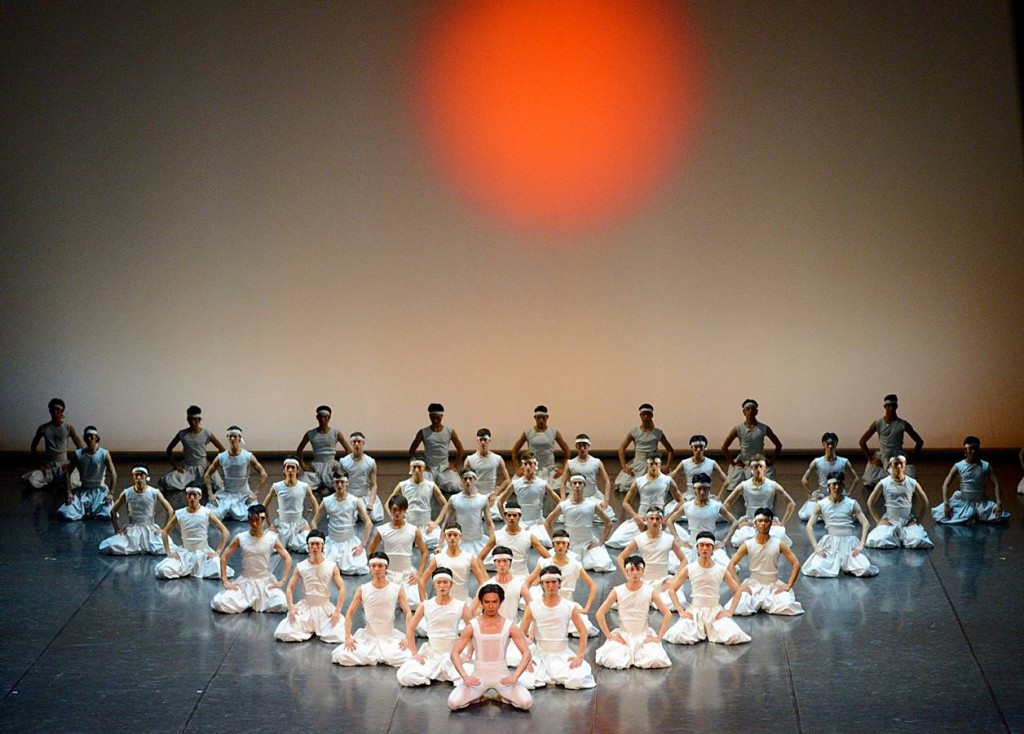“The Kabuki”
The Tokyo Ballet
Stuttgart State Opera
Stuttgart, Germany
June 08, 2014
by Ilona Landgraf
Copyright © 2014 by Ilona Landgraf
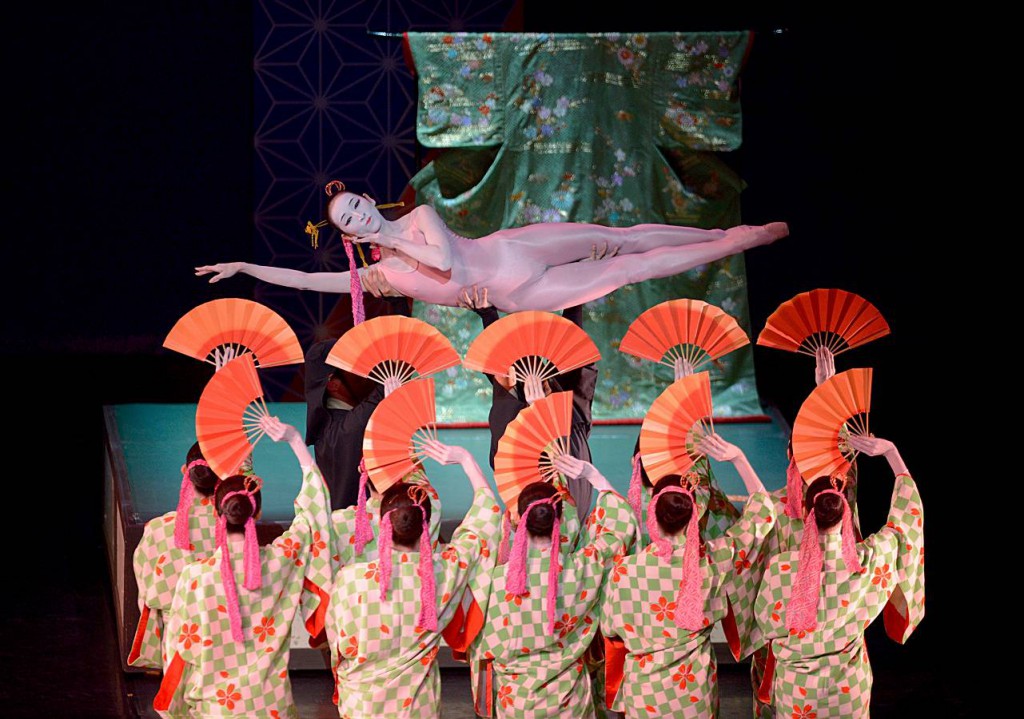 The Tokyo Ballet toured Stuttgart on June 7th and 8th with one of their core repertory pieces, Maurice Béjart’s “The Kabuki”, a dance-drama created for the troupe in 1986. The plot is based on the Japanese national myth “The Revenge of the 47 Ronin”, events which took place between 1701 – 1703 during the Edo period. The term ‘Ronin’ means ‘masterless samurai’ due to the master’s death or the loss of the master’s favor or privilege.
The Tokyo Ballet toured Stuttgart on June 7th and 8th with one of their core repertory pieces, Maurice Béjart’s “The Kabuki”, a dance-drama created for the troupe in 1986. The plot is based on the Japanese national myth “The Revenge of the 47 Ronin”, events which took place between 1701 – 1703 during the Edo period. The term ‘Ronin’ means ‘masterless samurai’ due to the master’s death or the loss of the master’s favor or privilege.
It’s an intricate story set in the circles of the Shogun. Morono, a high-level officer of the Shogun, is rejected by Lady Kaoyo, the wife of Lord Enya Hangan. Out of wounded vanity he starts to quarrel with the husband. Enya Hangan finally loses his temper and attacks the womanizer, earning more than he bargained for. Provoking fights inside the palace is forbidden and is punished with the stipulation to commit Seppuku, ritual suicide through disembowelment. He also has to dissolve his clan. Having no choice, he took his own life.
Led by the Bushido, Yuranosuke – ‘Bushido’ is a code of honor for samurai – forty six of Enya Hangan’s faithful followers later take revenge for their master. They attack Morono, behead him and after accomplishing the bloody deed, commit Seppuku 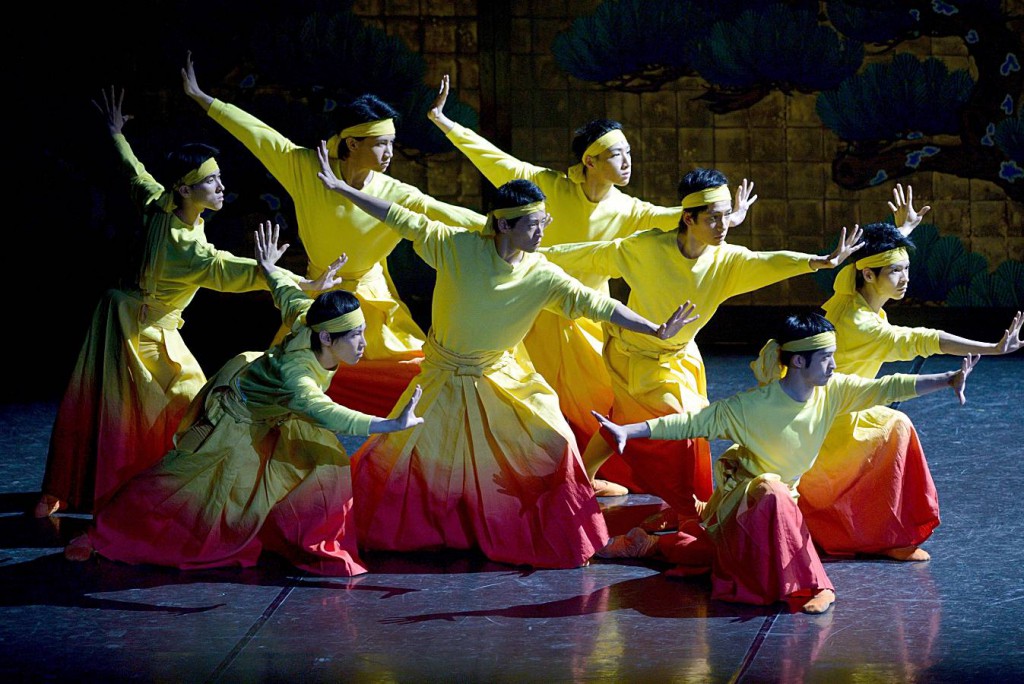 themselves. Above them, Japan’s symbol, the red sun, shone heavy with meaning on the group. Matters are complicated by additional storylines. One of them is the love affair between a young samurai and the maid of Lady Kaoyo. Just as this maid is to be sold off as a geisha, another chain of disastrous events unfold: a robbery, mistaken accusations and a further Seppuku. Thus, an additional cause to take revenge is given.
themselves. Above them, Japan’s symbol, the red sun, shone heavy with meaning on the group. Matters are complicated by additional storylines. One of them is the love affair between a young samurai and the maid of Lady Kaoyo. Just as this maid is to be sold off as a geisha, another chain of disastrous events unfold: a robbery, mistaken accusations and a further Seppuku. Thus, an additional cause to take revenge is given.
Béjart moreover interwove the present time into the traditional dance-drama. The first scene takes place in a hip Tokyo disco crammed with video screens, some of whose arrangement is faintly reminiscent of traditional shoji screens. Their flickering video clips, showing amongst others views of today’s Tokyo, created the nervousness of a media shop’s computer department. The young disco goers hopped around in silly movements to shrieking, shrill sounds until suddenly an old samurai sword was brought into play. – A rather implausible idea for beginning the story! Why on earth is there a samurai sword in a disco? To show that the past influences the present day and hence its new generation, regardless how ultramodern and stylized their world is? – One young man, though hesitating, finally took the sword, which initiated his time journey into the mythological events surrounding the 47 Ronin. At first merely an onlooker, the young timetraveller became more and more entangled in the historical drama. The present time and the past coalesced. Embarking on the way of a samurai he finally became Yuranosuke, the Ronin’s leader and the angel of revenge for Morono.
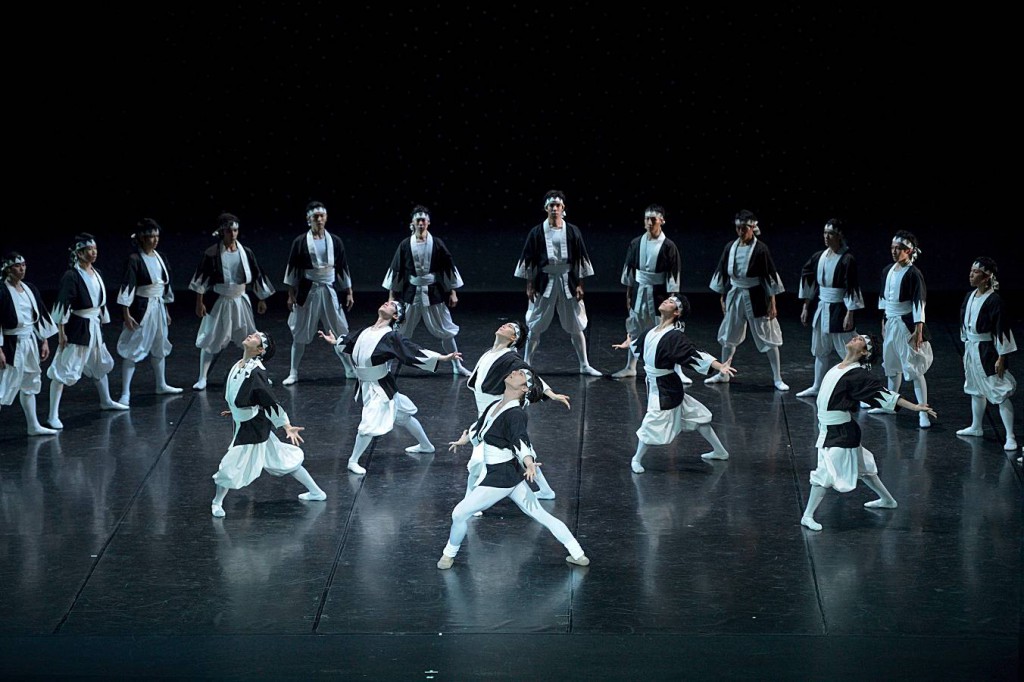 On other occasions wayfarers coming from the future strolled through the happenings, as if on an interactive sightseeing tour.
On other occasions wayfarers coming from the future strolled through the happenings, as if on an interactive sightseeing tour.
The prolog and the subsequent nine scenes were cleverly separated from each other by a striped curtain drawn by an almost completely hidden person (set and costumes by Nuno Côrte-Real). While the scenery was changed in the background, small interludes supplied entertainment in front of the curtain. The simulation of a young couple’s journey through the countryside was very effective. They hardly moved forward. Instead a beautifully painted panel of fabric was slowly pulled behind them suggesting scenery passing by.
The dancers wore mainly traditional Japanese garments such as samurai robes, yukatas or kimonos. The kimonos, colorfully and elaborately designed, and properly paraded, were a visual treat.
Toshiro Mayuzuni assembled traditional male sing-song, shamisen sounds and percussion to the joyous as well as sad tones of the bamboo flute in a recorded collage. The tunes made by small wooden blocks, struck together by a musician at the edge of the stage, had especial power.
Japan-aficionado Béjart combined the style of European ballet with traditional gestures and the dance vocabulary of the Kabuki. The dancers’ body control was consummate! In perfect harmony, the corps of dancers glided elegantly through group patterns like a rigidly organized flock of birds. Motionless on the surface while engaged in often formalistic dances they seemed unapproachable. I’m not familiar with Japanese culture and can only guess as to the deeper meaning of specific rituals or gestures like the eloquent movements of the women’s hands. But that I missed the initial approach of Morono to 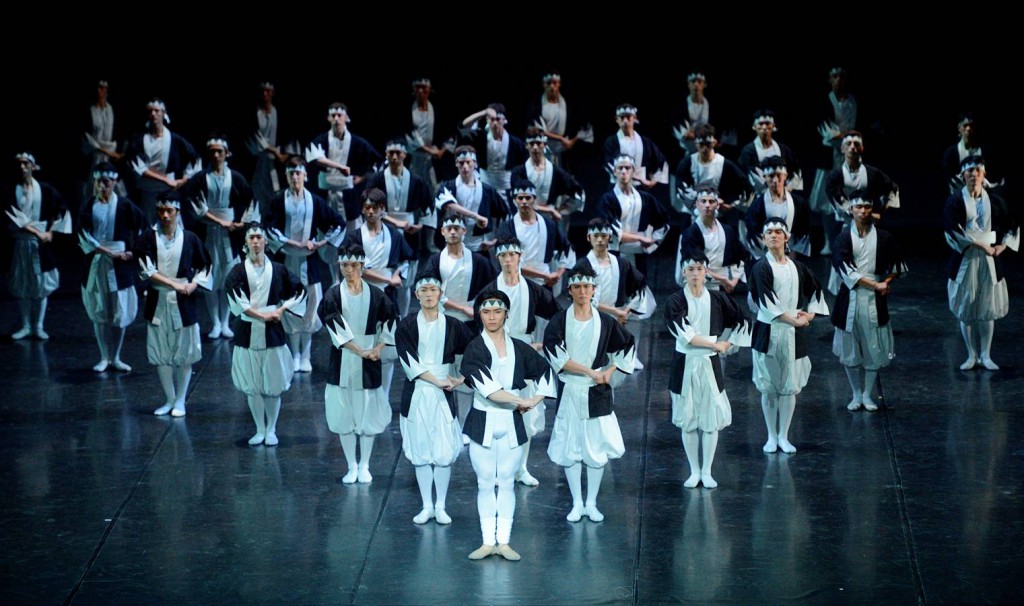 Lady Kaoyo and her rejection, the root of all evil after all, can’t be attributed to my lack of cultural knowledge, nor the emotional self control typical of the Japanese. It’s a dramaturgical weakness. Except for a few solos whose meaning remained cloudy, each respective scene had by and large comprehensible action. The overall storyline, however, was intricate. What’s more, instead of relying on the traditional Kabuki’s inherit power, Béjart repeatedly slipped in showy effects and pathos, such as soulful looks towards the glowing red sun or a stage floor, suddenly turning bloody-red. When it comes to honor, pride and ritual suicide, getting pathetic isn’t far. This should be avoided so as to not risk the protagonists’ dignity.
Lady Kaoyo and her rejection, the root of all evil after all, can’t be attributed to my lack of cultural knowledge, nor the emotional self control typical of the Japanese. It’s a dramaturgical weakness. Except for a few solos whose meaning remained cloudy, each respective scene had by and large comprehensible action. The overall storyline, however, was intricate. What’s more, instead of relying on the traditional Kabuki’s inherit power, Béjart repeatedly slipped in showy effects and pathos, such as soulful looks towards the glowing red sun or a stage floor, suddenly turning bloody-red. When it comes to honor, pride and ritual suicide, getting pathetic isn’t far. This should be avoided so as to not risk the protagonists’ dignity.
The symbol of the rising sun was an overused sledgehammer. One ought to question degrading an culturally important myth to a stage spectacle.
The company’s commitment and prowess was captivating. Mao Morikawa danced the unswerving and courageous Yoranosuke, Hiroki Umezawa was Lord Enya Hangan, Rie Watanabe was his wife Lady Kaoyo. Morono, the initial troublemaker, was danced by Yoshihiro Harada. Junya Okazaki was Bannai, Morono’s liegeman, a murky character in the disguise of a jester.
One of the evening’s most important moments was the final curtain call, when unexpectedly a light blue cloth was let down from the ceiling, with silvery glistening letters giving thanks to the Tokyo Ballet and expressing Stuttgart’s hope to ‘see you soon!’. A wave of warmth pervaded the audience, instantly bridging all cultural diversities.
| Link: | The Tokyo Ballet’s Homepage | |
| Photos: | 1. | Ensemble, “The Kabuki” by Maurice Béjart, The Tokyo Ballet 2014 |
| 2. | Ensemble, “The Kabuki” by Maurice Béjart, The Tokyo Ballet 2014 | |
| 3. | Samurai (Ronin), Ensemble, “The Kabuki” by Maurice Béjart, The Tokyo Ballet 2014 | |
| 4. | Samurai (Ronin), Ensemble, “The Kabuki” by Maurice Béjart, The Tokyo Ballet 2014 | |
| 5. | Samurai (Ronin), Ensemble, “The Kabuki” by Maurice Béjart, The Tokyo Ballet 2014 | |
| all photos © Stuttgart Ballet 2014 | ||
| Editing: | Laurence Smelser |
